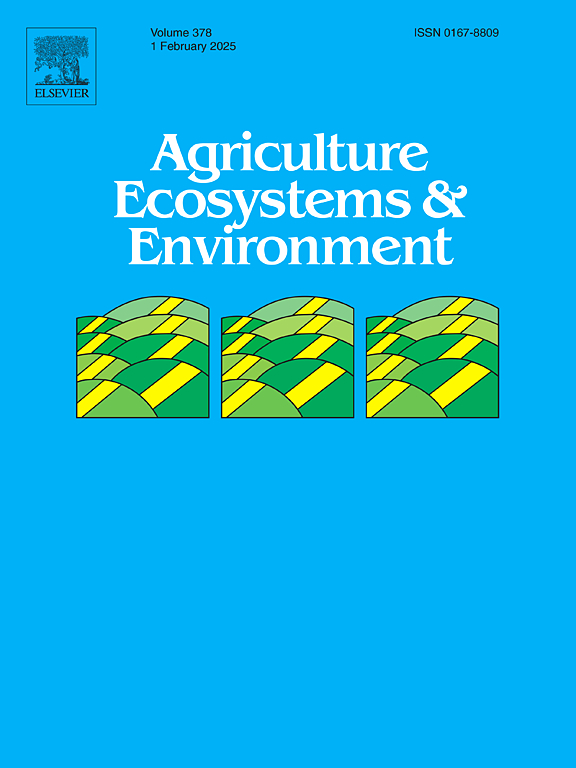Understanding farm-level diversity to guide soil fertility management in West African cotton systems: Evidence from Benin
IF 6
1区 农林科学
Q1 AGRICULTURE, MULTIDISCIPLINARY
引用次数: 0
Abstract
Although cotton cultivation grants farmers access to annual inputs of mineral fertilisers, there is a generalised tendency of soil fertility decline in Benin’s cotton-growing area. This study aimed to understand the link between farm socioeconomic diversity, soil management practices, and soil fertility status in cotton-based farming system of Benin. Socio-demographic and farm management data were collected from 242 farms on three sites in southern-central and northern Benin. Principal component analysis and a hierarchical clustering were used to construct a farm typology. Soil management practices were analysed in the light of this typology. Composite soil samples 20 cm deep were then taken from 40 plots representing the farm/soil types identified, to assess variability in soil fertility as influenced by farm types and management practices. Four farm types emerged, differing in resource endowments and soil management practices. Practices such as manure application (92 %) and rotational herd corralling (42 %) were adopted more often by livestock owners. Farms without livestock implemented practices such as crop rotation (90 %) and intercropping (41 %). Soil fertility status was low to very low in all farms sampled across the three sites (extractable phosphorus <10 mg P/kg soil, soil organic matter < 20 g kg−1 soil). Although a link between farms’ soil management practices and soil fertility status was expected, no statistical differences were detected across farm types (p > 0.05). Cotton yields, as declared by farmers, were also not statistically associated with soil fertility levels. The generalized poor fertility status of soils that receive annual fertilizer inputs suggests that this practice is not enough to maintain long-term soil productivity in the climatic and soil conditions of Benin cotton zones studied here. This was also the case in fields that received combinations of mineral fertiliser and animal manure, which is probably not used in sufficient quantity and quality. Low organic matter inputs, crop residue removal and conventional tillage, as practiced by the majority of farmers in our study sites (100 %), may contribute to explain the low levels of SOM and organically-held nutrients in the soil. Alternative measures to maintain soil fertility should be further investigated locally for their capacity to restore and maintain soil fertility in the long term and to improve crop yields, considering the socioeconomic diversity of farms and their environment.
了解农场层面的多样性以指导西非棉花系统的土壤肥力管理:来自贝宁的证据
虽然种植棉花使农民有机会获得每年投入的矿物肥料,但在贝宁的棉花种植区,土壤肥力普遍下降。本研究旨在了解贝宁以棉花为基础的农业系统中农业社会经济多样性、土壤管理实践和土壤肥力状况之间的联系。从贝宁中南部和北部三个地点的242个农场收集了社会人口和农场管理数据。采用主成分分析和分层聚类方法构建农场类型。根据这一类型学分析了土壤管理实践。然后从代表已确定的农场/土壤类型的40个地块中提取20 cm深的复合土壤样品,以评估受农场类型和管理做法影响的土壤肥力变异性。出现了四种不同资源禀赋和土壤管理方法的农场类型。牲畜所有者更常采用的做法,如施用粪肥(92% %)和轮牧(42% %)。没有牲畜的农场采用了轮作(90% %)和间作(41% %)等做法。在三个地点取样的所有农场中,土壤肥力状况都很低或很低(可提取磷<;10 mg P/kg土壤,土壤有机质<; 20 g 公斤−1土壤)。虽然预计农场土壤管理实践与土壤肥力状况之间存在联系,但在不同农场类型之间没有发现统计学差异(p >; 0.05)。农民所宣称的棉花产量与土壤肥力水平也没有统计学上的联系。每年接受肥料投入的土壤肥力状况普遍较差,这表明在本研究的贝宁棉花区气候和土壤条件下,这种做法不足以维持长期的土壤生产力。在使用矿物肥料和动物粪便的混合肥料的田地中也是如此,这些肥料的使用数量和质量可能都不够。在我们的研究地点(100% %),大多数农民都采用了低有机质投入、作物残茬去除和传统耕作方式,这可能有助于解释土壤中SOM和有机养分含量低的原因。考虑到农场及其环境的社会经济多样性,应在当地进一步调查维持土壤肥力的替代措施,以确定其长期恢复和维持土壤肥力以及提高作物产量的能力。
本文章由计算机程序翻译,如有差异,请以英文原文为准。
求助全文
约1分钟内获得全文
求助全文
来源期刊

Agriculture, Ecosystems & Environment
环境科学-环境科学
CiteScore
11.70
自引率
9.10%
发文量
392
审稿时长
26 days
期刊介绍:
Agriculture, Ecosystems and Environment publishes scientific articles dealing with the interface between agroecosystems and the natural environment, specifically how agriculture influences the environment and how changes in that environment impact agroecosystems. Preference is given to papers from experimental and observational research at the field, system or landscape level, from studies that enhance our understanding of processes using data-based biophysical modelling, and papers that bridge scientific disciplines and integrate knowledge. All papers should be placed in an international or wide comparative context.
 求助内容:
求助内容: 应助结果提醒方式:
应助结果提醒方式:


